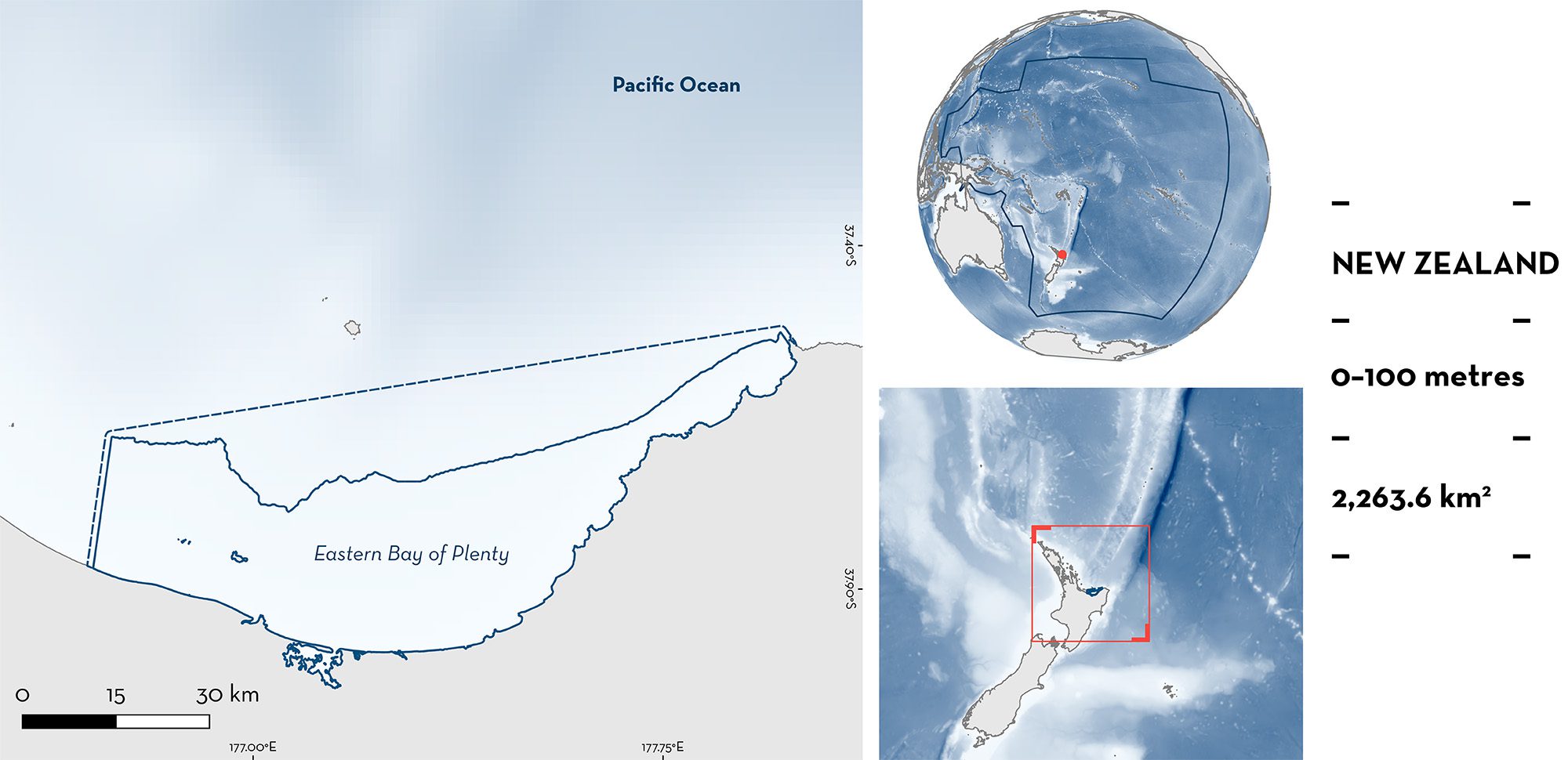ISRA FACTSHEETS
ISRA FACTSHEETS
NEW ZEALAND & PACIFIC ISLANDS REGION
Eastern Bay of Plenty
Summary
Eastern Bay of Plenty is located in northeast New Zealand. The area is characterised by inner and outer shelf benthic habitats dominated by sands and gravels. It includes Ōhiwa Harbour, a large estuarine system as well as rocky reef habitats. The area overlaps the North Eastern North Island (offshore) Key Biodiversity Area. Within this area there are: threatened species and reproductive areas (Smooth Hammerhead Sphyrna zygaena).
Download factsheet
Eastern Bay of Plenty
DESCRIPTION OF HABITAT
Eastern Bay of Plenty is located on the northeast side of New Zealand’s North Island. The area is characterised by a largely sandy coastline west of Opape and mainly rocky coastline east of it. It includes Ōhiwa Harbour, a large estuarine system. The harbour is shallow (<11 m) and is characterised by extensive intertidal flats with a large portion of it drying at low tides. Inner and outer shelf habitats in Eastern Bay of Plenty are predominantly sands, interspersed with patchy gravels. Offshore rocky reef habitat is largely confined to the area around Moutohora (Whale Island) and Rurima Island. Shallow rocky reefs occur as a band along the coastline (Haggitt et al. 2008).
The major oceanographic influence on the Eastern Bay of Plenty is the East Auckland Current (Chapell 2013; Stevens et al. 2021). This is a western boundary current formed by the reattachment of an extension of the East Australian Current to the New Zealand continental margin off North Cape. The East Auckland Current flows southward as a series of warm core eddies and then turns east across the Bay of Plenty, before flowing south again at East Cape. For most of the year, it is located beyond the 1,000 m isobath but during austral summer northeast winds push oceanic water onto the shelf. Average sea surface temperatures range from ~14°C in August (winter) up to 21°C in February (summer) (Chappell 2013).
The area overlaps with the North Eastern North Island (offshore) Key Biodiversity Area (KBA 2024).
This Important Shark and Ray Area is benthic and pelagic and is delineated from inshore and surface waters (0 m) to 100 m based on the bathymetry of the area.
CRITERION A
VULNERABILITY
One Qualifying Species considered threatened with extinction according to the IUCN Red List of Threatened Species regularly occurs in the area. This is the Vulnerable Smooth Hammerhead (Rigby et al. 2019).
CRITERION C
SUB-CRITERION C1 – REPRODUCTIVE AREAS
Eastern Bay of Plenty is an important reproductive area for one shark species.
Based on commercial catch data (mostly set nets, bottom longlines and bottom trawls) from 2005–2014 and trawl surveys between 1961–2014 from New Zealand’s North Island, neonates and young-of-the-year (YOY) Smooth Hammerheads are regularly caught in Eastern Bay of Plenty (Francis 2016; CAJ Duffy pers. obs. 2024). Of 208 individuals recorded in trawl surveys, 55.3% (n = 115) were <60 cm total length (TL), with smaller sharks observed in summer and early autumn (January–March; Francis 2016). The reported size-at-birth for the species is 49–63 cm TL (Ebert et al. 2021) confirming these were neonates or YOY. Eastern Bay of Plenty and Firth of Thames were the areas with the largest number of these life stages recorded during the trawl surveys. In addition, juveniles (~100 cm TL) were also common in Eastern Bay of Plenty, especially in the eastern side of the area, around Whakatane (Francis 2016). Historical research trawl surveys conducted between 1961–1997 also suggested that Eastern Bay of Plenty was one of the areas with higher catches of Smooth Hammerheads in all New Zealand waters, along with the Firth of Thames (Anderson et al. 1998). YOY individuals are still observed in the area by recreational anglers (iNaturalist 2024; CAJ Duffy pers. obs. 2024).
Download factsheet
SUBMIT A REQUEST
ISRA SPATIAL LAYER REQUEST
To make a request to download the ISRA Layer in either a GIS compatible Shapefile (.shp) or Google Earth compatible Keyhole Markup Language Zipped file (.kmz) please complete the following form. We will review your request and send the download details to you. We will endeavor to send you the requested files as soon as we can. However, please note that this is not an automated process, and before requests are responded to, they undergo internal review and authorization. As such, requests normally take 5–10 working days to process.
Should you have questions about the data or process, please do not hesitate to contact us.


